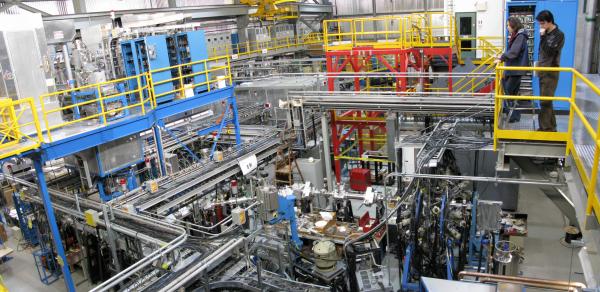The TRIUMF Isotope Separation and Acceleration (ISAC) facility
The universe, though composed mostly of hydrogen and helium, also contains heavy elements. These are formed in stars, through the gradual accretion of alpha particles to form increasingly massive nuclei, or by the rapid, multiple capture of protons, neutrons, etc. by more medium-sized nuclei - quite often unstable, radioactive ones.
These kinds of interactions - leading to the production of heavy elements - are of increasing interest to astrophysicists. How can we study these reactions involving radioactive, larger nuclei? Some of them have half-lives of less than one second!
During the past ten years, a group at TRIUMF has built a facility that can create and isolate many of these interesting, short-lived nuclei of intermediate mass. The equipment is called TISOL (TRIUMF Isotope Separator On-Line).
TISOL essentially creates the desired radioactive isotopes by bombarding a suitable target with energetic protons from TRIUMF's cyclotron. It then separates these radioisotopes from others that may be formed simultaneously, and provides them to experimenters as a low-speed beam of particles.
The ISAC facility is the next phase of this project - a linear accelerator that speeds up these radioactive particle beams to much higher velocities. The facility allows us to simulate reactions which may be occurring when stars explode. While scientists understand the nuclear reactions occuring within many stellar environments, a clear picture of the very hot environments of novae, supernovae, or X-ray bursts has eluded them. They believe that these hot environments lead to reactions involving radioactive species. TRIUMF's ISAC enables us to simulate and study the very reactions occurring in those nova explosions.
Through the ISAC facility, TRIUMF has become one of the world centres for the study of nuclear astrophysics and element synthesis in the universe. For example, a pressing question at present involves the intensity of the neutrinos we observe coming from the sun. The expected intensity is based upon our understanding of the reactions that occur in stars, and we use the so-called "solar model" to calculate this intensity. (This model has successfully predicted the observed distributions of the elements in the universe.) From our observations on earth, however, we find the solar neutrinos have an intensity far less than we expected. We need to know why.

In addition to studying explosive events in the universe, scientists using ISAC also explore the mysteries of the "Standard Model" (a term used to describe the current theory covering the relationships between all the known elementary particles and forces). This model attempts to provide us with a clear picture of the ultimate basis of all matter. It describes and explains unusual entities like quarks, gluons, and kaons. Physicists at various high-energy accelerators around the world test the limitations of this model. Seeking new particles, they use a "brute force" approach to shatter the nucleus and reveal its inner secrets. (A recently cancelled American project, the Superconducting Super Collider, was being built for this purpose.) However, an alternative approach is to do very sensitive, clever studies at much lower energies, in order to probe the limits of the Standard Model. A major study along these lines is in progress at TRIUMF using the existing equipment to create different types of radioactive beams. For example, by producing significant amounts of the short-lived radioactive species potassium-37, then trapping the atoms with laser light beams in TRIUMF's Neutral Atom Trap (TRINAT) and lining them up in a specific direction, TRIUMF scientists can study the symmetry in how this potassium nucleus emits particles, and from this they can test the predictions of the Standard Model. In another study, intense beams of the radioactive element francium will be trapped with laser light. A study of some rare atomic transitions will reveal parameters of the Standard Model that complement (but do not duplicate) studies from high-energy accelerator labs. These rare atomic transitions are affected by the electroweak interactions and their intensity is a measure of this interaction.
Performing these world-class and significant studies will require the highest radioactive beam intensities available in the world. The ISAC facility provides just that. It utilizes the very intense, intermediate-energy proton beam from the TRIUMF cyclotron to produce many species of interest. Using the knowledge gained since 1985 with TISOL, we extract these species of interest in a new ISOL facility. Then, as needed, we accelerate these heavy ions to the desired velocities to perform the studies.
ISAC significantly increase the types of projectiles available at TRIUMF. These species can be used for a wide range of studies over and above those mentioned earlier, and the range of applications can include materials science, industrial uses, atomic physics, surface science, nuclear structure explorations of very deformed nuclei, and many more.
